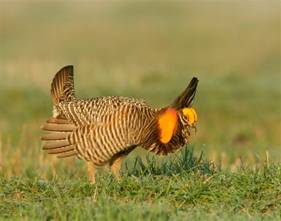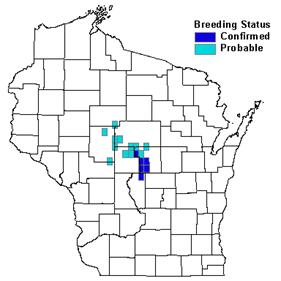

Status/Protection
- Global Rank: G4 Key to global and state ranks
- State Rank: S1B, S2N
- WBCI Priority: SGCN, PIF, State Threatened
Population Information
The Federal BBS information can be obtained at http://www.mbr-pwrc.usgs.gov/bbs/bbs.html by clicking on Trend Estimates and selecting the species in question. All estimates are for time period (1966-2005).
*Note: There are important deficiencies with these data. These results may be compromised by small sample size, low relative abundance on survey route, imprecise trends, and/or missing data. Caution should be used when evaluating this trend.
- Federal Breeding Bird Survey: significant decline
- Federal Breeding Bird Survey (WI): non-significant decline*
- Federal Breeding Bird Survey (BCR 23): non-significant decline*
- Federal Breeding Bird Survey (BCR 12): significant increase*
- Central Wisconsin Prairie Chicken Census: see report for details
- WSO Checklist Project: stable (1983-2007)
Life History
- Breeding Range: North Dakota south to Oklahoma with isolated populations in Texas, Minnesota, Wisconsin, Illinois, and Missouri (Schroeder and Robb 1993).
- Breeding Habitat: Idle Cool-season Grasses, Idle Warm-season Grasses, Dry-mesic Prairie, Wet-mesic Prairie, Wet Prairie, Northern Sedge Meadow.
- Nest: Ground.
- Nesting Dates: April-June.
- Foraging: Ground Glean.
- Migrant Status: Resident.
- Habitat use during Migration: N/A
- Arrival Dates: N/A
- Departure Dates: N/A
- Winter Range : same as breeding range.
- Winter Habitat: same as above.
Habitat Selection
Throughout their range, Greater Prairie-Chickens require large grassland landscapes with high amounts of open space (Schroeder and Robb 1993). Westemeier (1971) determined that on the BV marsh higher amounts of long-term and permanent grassland cover within a mile of a booming ground resulted in higher numbers of male Greater Prairie-Chickens on the booming grounds. The number of males at a lek within the northern range of the Greater Prairie-Chickens in Wisconsin also correlated positively with the amount of grassland cover at multiple spatial scales surrounding the lek (Neimuth 2000). Management of Greater Prairie Chicken core areas should consist of the following landscape components (from Hamerstrom et al. 1957, Sample and Mossman 1997):
- A large area (10,000 to 50,000 acres) of open landscape not more than 20% wooded with wooded tracts in small, scattered blocks and a limited number of linear treelines.
- A core of permanent managed grassland at least 2,000 acres in size for every 10,000 acres of Greater Prairie-Chickens range.
- A minimum of 30% of the open lands in permanent grassland, including the core and scattered blocks of grassland at least 80 acres or larger in size.
- Scattered blocks of long-term grass cover (e.g. CRP, CREP and pasture) totaling an additional 15-20% of the open landscape;
- Adequate winter food supply.
Greater Prairie-Chickens have complex habitat requirements due to differing life history needs throughout the year. Large patches of older-successional grassland with a well-developed litter layer and vegetation heights of greater than 20 cm are required for nesting and roosting cover. However; they also need insect rich grasslands, pastures, and crop field for feeding and short-grass fields for lek sites. Managing for chickens will require having all of these habitats available within a mile of the booming ground site.
Habitat Availability
Greater Prairie-Chickens require the largest tracts of grassland of all the grassland birds in Wisconsin. This large area requirement is difficult to attain, making availability extremely limited (Knutson et al. 2001). Currently over 90% of chickens are found on managed wildlife areas (Buena Vista/Leola Grasslands, Mead/Paul J. Olson Grasslands Wildlife Areas) that contain large areas of grassland habitat managed specifically for chickens (Warnke 2004). Small numbers of chickens also exist in western Marathon and eastern Clark Counties where private land use still supports these birds, however; this population has declined dramatically in recent years.
There are very few other landscapes in the state with current conditions suitable for Greater Prairie-Chicken reintroduction. Grasslands in the Military Ridge Prairie Heritage Area hold the potential for a viable population due to the high acreages of CRP and potential for future acquisition efforts by conservation groups. Reintroduction has been attempted in Crex Meadows Wildlife Area but was not successful (Evrard 2004).
Population Concerns
Recent research studies documented a lack of dispersal between sub-populations within the chicken range (Toepfer 2003) resulting in reduced genetic diversity of the overall Greater Prairie-Chicken population in Wisconsin (Johnson et al. 2003). Severe long-term loss of idle grasslands in the northern range and away from managed core areas has exacerbated the dispersal problem and is now the focus of renewed efforts for grassland birds in the chicken range (Warnke 2004).
Recommended Management
Grassland restorations should focus on contributing to the landscape model provided above. Smaller grassland restorations (200-500 acres) within open landscapes between managed areas are necessary to help re-connect isolated sub-populations.
Grasslands (>80 acres) managed as nesting/roosting cover should have 100% VOR at 25 cm and structure similar to managed smooth brome (Svedarsky et al. 2003). Nesting cover should compose at least 25-30% of total management areas, should be near a similar percentage of brood habitats, and should be available in early March to facilitate the greater productivity of early nests (Svedarsky et al. 2003). Ensure that some litter is present, but dense litter depths and vegetation >50cm are discouraged (McKee et al. 1998). Rejuvenate nesting cover periodically (5 year rotations) to control woody growth and deep litter depths (Svedarsky et al. 2003).
Brood habitat should be located adjacent to nesting cover, provide abundant insect resources and facilitate chick movement at ground level (Svedarsky et al. 2003). Fallow fields, burned, grazed or recently disturbed grasslands (Walk 2004), and row crops (Toepfer 2003) are used as brood habitat.
Follow the guidelines from the Greater Prairie-Chicken Genetics Committee for chicken translocation in order to increase genetic diversity in the Wisconsin population.
Research Needs
Continue to accurately monitor populations at leks in central Wisconsin and monitor lek establishment and size with respect to recent grassland restorations. New research should focus on evaluating the success of translocation efforts with respect to genetic diversity and overall population viability. More research is needed to determine optimal management regimes for maximizing chicken populations on managed grassland areas. Evaluating the use of pastures and other agricultural grassland types by chickens would help managers with future conservation strategies. Toepfer (2003) lays out a series of research recommendations for consideration including some of those listed above.
Information Sources
- David Sample, Grassland Community Ecologist, Wisconsin DNR Research Center, 1350 Femrite Dr., Monona, WI 53716.
- North American Breeding Bird Survey: http://www.npwrc.usgs.gov
- Temple S. A., J. R. Cary, and R. Rolley. 1997. Wisconsin Birds; A Seasonal and Geographical Guide. Wisconsin Society of Ornithology and Wisconsin Department of Natural Resources, Madison, WI.
- Toepfer, J. E. 2003. Prairie chickens & grassland: 2000 and beyond. A report to the council of chiefs. Society Tympanuchus Cupido Pinnatus, Ltd. Elm Grove, WI. USA. 69 pp.
- Warnke, K. 2004. Wisconsin Greater Prairie-Chicken Management Plan 2004-2014. Wisconsin Department of Natural Resources.
- Wisconsin Breeding Bird Atlas: http://www.uwgb.edu/birds/wbba/
References
- Evrard, J.O. The Greater Prairie-Chicken in Crex Meadows: An Unsuccessful Restoration Attempt. 2004. Passenger Pigeon 66:No. 3.
- Hamerstrom, F. N. Jr., O. E. Mattson, and F. Hamerstrom. 1957. A guide to prairie chicken management. Wisconsin Tech. Wildlife Bull. 15. Wisconsin Conservation Department. Madison, WI. USA. 128 pp.
- Johnson, J. A., J. E. Toepfer, and P. O. Dunn. 2003. Contrasting patterns of mitochondrial and microsatellite population structure in fragmented populations of greater prairie-chickens. Molecular Ecology 12:3335-3347.
- Knutson, M. G., G. Butcher, J. Fitzgerald, and J. Shieldcastle. 2001. Partners in Flight Bird Conservation Plan for The Upper Great Lakes Plain (Physiographic Area 16). USGS Upper Midwest Environmental Sciences Center in cooperation with Partners in Flight. La Crosse, WI.
- Niemuth, N. D. 2000. Land use and vegetation associated with greater prairie-chicken leks in an agricultural landscape. Journal of Wildlife Management 64:279-286.
- Robbins, S. D., Jr. 1991. Wisconsin Birdlife: Population and distribution past and present. Madison, WI: Univ. Wisconsin Press.
- Sample, D. and M. Mossman. 1997. Managing Habitat for Grassland Birds: A guide for Wisconsin. Wisconsin Department of Natural Resources: Madison, WI.
- Schroeder, M. A. and L. A. Robb.1993. Greater Prairie-Chicken. In the Birds of North America, No. 36 (A. Poole, P. Stettenheim, and F. Gill eds.). Philadelphia: The Academy of Natural Sciences; Washington, D.C.: The American Ornithologists’ Union.
- Svedarsky, W. D., J. E. Toepfer, R. L. Westemeier, and R. J. Robel. 2003. Effects of management practices on grassland birds: Greater Prairie-Chicken. Northern Prairie Wildlife Research Center, Jamestown, ND. Northern Prairie Wildlife Research Center Online. http://www.npwrc.usgs.gov/resource/literatr/grasbird/gpch/gpch.htm (Version 28MAY2004).
- Toepfer, J. E. 2003. Prairie chickens & grassland: 2000 and beyond. A report to the council of chiefs. Society Tympanuchus Cupido Pinnatus, Ltd. Elm Grove, WI. USA. 69 pp.
- Walk, J. W. 2004. A plan for the recovery of the Greater Prairie-Chicken in Illinois. University of Illinois, Urbana, Illinois. Office of Resource Conservation, Illinois Department of Natural Resources, Springfield, Illinois 72 pp.
- Warnke, K. 2004. Wisconsin Greater Prairie-Chicken Management Plan 2004-2014. Wisconsin Department of Natural Resources.
- Westemeier, R. L. 1971. The History and Ecology of Prairie Chickens in Central Wisconsin. Research Bulletin 281. University of Wisconsin.
Contact Info
- Compiler: Jenny Herrmann, mherrmann@wi.rr.com
- Editor: Jim Keir, Wisconsin DNR Biologist
